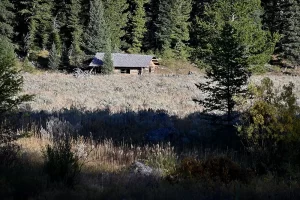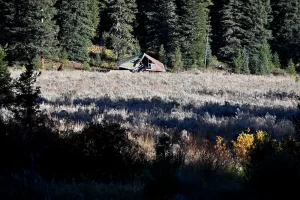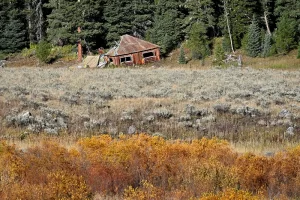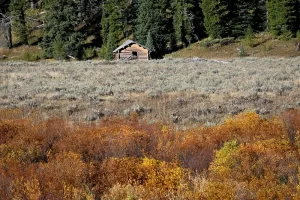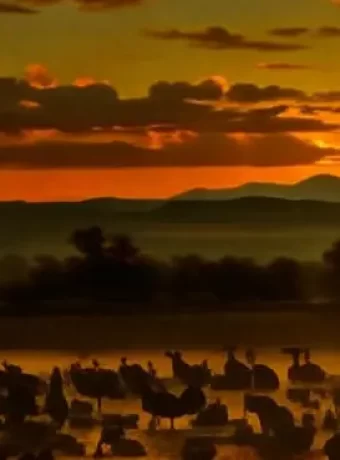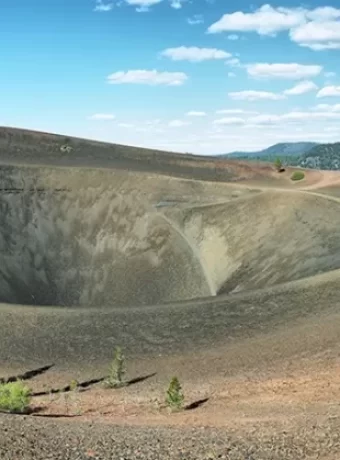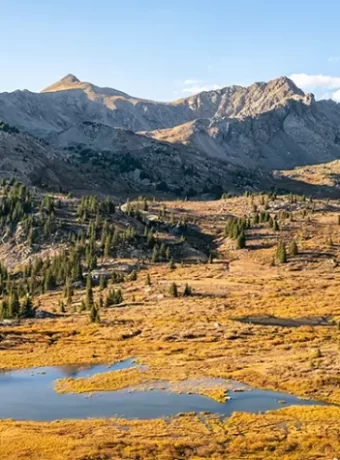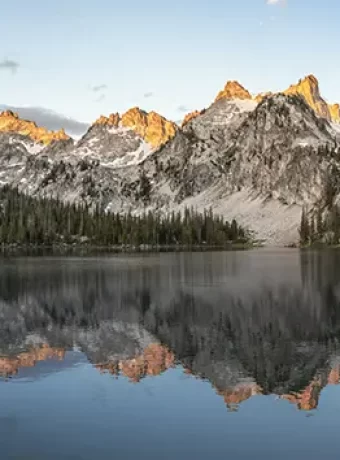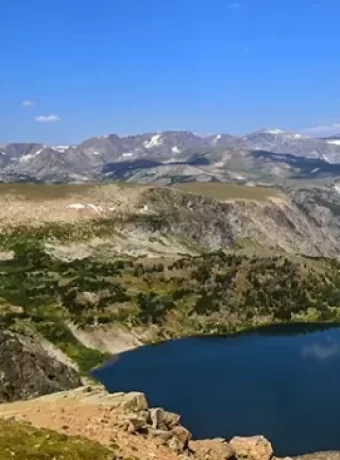Before and After: The 1959 Hebgen Lake Earthquake Impact
On August 17, 1959, the earth beneath us trembled profoundly, altering not only the terrain but also revolutionizing our perception of nature’s fury. This piece dives into the Before and after 1959 Hebgen Lake earthquake, offering insights into how this event reshaped Yellowstone National Park and its surrounding areas. You’ll get to know about the immediate chaos it unleashed, leading to panic among campers and massive land alterations.
I have stood above Earthquake Lake over the years at sunrise and set, even during the day wondering what it truly was like. Known to some as a night of terror or the earth shook, the mountain fell, even the lake tilted. That’s a lot of movement in a few minutes or seconds.
Delving into the origins of Earthquake Lake, we’ll uncover the dramatic transformation wrought by nature’s might, birthing new terrains as if conjured from thin air. Additionally, you’ll learn about the resilience shown during rescue operations and how Yellowstone’s famed geysers were forever changed.
Embarking on this exploration, we’ll delve deep into Montana’s monumental seismic event—examining its effects on the natural world, the surrounding communities, and how it has shaped our understanding for those who come after us. Learn more about Hebgen Lake Recreation Area and spent some time fly fishing, hiking, camping, and photography.
Table Of Contents:
- The Night That Changed Yellowstone Forever: Understanding the 1959 Hebgen Lake Earthquake
- Before the Quake: Yellowstone and Its Geological Setting
- The Moment Disaster Struck
- Formation of Earthquake Lake
- The Aftermath and Rescue Operations
- The Lasting Impact on Hydrothermal Features
- Ripple Effect on Wildlife and Environment
- Cultural Reflections on Natural Disasters
- The Role Of Technology In Understanding Seismic Events
- Navigating Recovery And Resilience In Yellowstone
- A Legacy Carved By Nature’s Force
- FAQs in Relation to Before and After 1959 Hebgen Lake Earthquake
- Conclusion of Before and After 1959 Hebgen Lake Earthquake
- Camp on Hebgen Lake Near Quake Lake Explore History
The Night That Changed Yellowstone Forever: Understanding the 1959 Hebgen Lake Earthquake
Picture Yellowstone, a sanctuary of serenity and splendor, existing in its own peaceful bubble. But on one fateful night in August 1959, everything changed. Under the cloak of darkness, Hebgen Lake was violently shaken by an earthquake so powerful it forever altered the very essence of its terrain.
On that night, not just any shiver ran through the earth; a colossal upheaval measuring 7.3 on the Richter scale, it stood out as one of Montana’s most monumental seismic shifts. The quake’s epicenter was near Hebgen Lake, close to West Yellowstone, altering not only the geography but also impacting lives deeply—with 28 people losing their lives in this disaster.
Campers in Madison Canyon
In what can only be described as sheer terror for those present, campers nestled within Madison Canyon found themselves amidst nature’s fury unleashed without warning. Rock slides blocked highways while panic ensued among tourists trapped by debris or seeking escape from rising waters—a testament to nature’s unpredictable power.
The aftermath saw incredible winds generating waves so powerful they overturned vehicles and transformed serene landscapes into chaos overnight—landscapes that visitors had come far and wide to see for their peaceful splendor now lay altered beyond recognition.
Incredible Winds and Waves Unleashed
Beyond immediate human impacts, the quake prompted a large landslide carrying roughly 50 million cubic yards of earth material which dammed up Madison River creating what is now known as Earthquake Lake—a stark reminder carved into Montana’s rugged terrain illustrating nature’s capacity to create even as it destroys.
The new water body emerging post-disaster didn’t just reshape local geology; it sparked extensive rescue operations involving helicopters flying over treacherous terrains—an effort dubbed “If you go, I go” symbolizing solidarity amongst first responders working tirelessly amid uncertain conditions towards saving trapped individuals across newly formed dams partially burying campsites under debris masses.
Years passed since that transformative night yet lessons remain ingrained about resilience against future seismic activities within such volatile geological settings where once stood idyllic sceneries disrupted suddenly leaving behind narratives woven through survival tales amid devastation—an enduring legacy highlighting both vulnerability faced by humans when confronting natural disasters alongside our collective strength found amidst adversities posed by unforgiving forces shaping planet Earth dynamically throughout ages past till today forming intrinsic parts defining human experiences shared universally transcending time itself beyond mere memories captured briefly then lost again like whispers carried away swiftly along gusts blowing gently across lands forever marked by traces left behind following events unfolding dramatically during nights changing worlds entirely seemingly instantaneously reflecting inherent unpredictability characterizing existence entwined closely with whims dictated largely upon whimsical moods governing natures abound globally. This story highlights the fragile equilibrium between human life and the natural world, emphasizing our need to cultivate endurance and flexibility amidst unforeseeable trials.
Hebgen Lake Earthquake Note:
Yellowstone’s 1959 Hebgen Lake earthquake was a game-changer, showing nature’s power to transform landscapes and lives overnight. It taught us resilience and the importance of being prepared for nature’s unpredictable challenges.
- Madison River Canyon Ghost Town, or what's left of cabins and camps of the 1959 earthquake.
Before the Quake: Yellowstone and Its Geological Setting
Tucked away on America’s western frontier, Yellowstone National Park cradles a geologic saga as captivating as the eruptions of its famed geysers amidst an expanse cherished for its natural beauty. Before 1959, this area was not just a haven for wildlife and adventurers but also a site on the brink of seismic change.
Perched on a volcanic furnace, the park’s landscape—every mound, hollow, and effervescent spring—is sculpted by this fiery undercurrent. West Yellowstone beckons as a gateway to this majestic realm, embodying the silent yet potent forces of nature that slumber beneath our very steps. Our appreciation for the terrain we marvel at today is deeply influenced by dormant yet influential fault lines, integral to the region’s intricate geological composition.
Understanding Yellowstone’s Volcanic Roots
Peering beneath Yellowstone’s tranquil surface reveals a subterranean realm, the key to its distinctiveness. Beneath those serene hot springs lies one of Earth’s largest active volcanoes—the Yellowstone volcano—whose last eruption over 640,000 years ago left behind the caldera upon which much of the park now rests.
This immense heat source powers hydrothermal features like Old Faithful Inn stands beside—one among many geysers testifying to ongoing subsurface activities. These natural wonders draw visitors from around globe year after year; however they’re reminders too powerful forces simmer below waiting erupt once more potentially reshaping land anew.
Fault Lines Framing Paradise
The mysterious allure of places like Madison Fault, with its significant role in molding the landscape through eons of seismic activity, captivates those who ponder the earth’s power to transform itself. This particular fault is part component larger tectonic puzzle affecting whole Rocky Mountain region – it’s movements responsible some degree shifting valleys creating spaces geyser basins fill with steaming water spurting skyward thanks Earth ’s internal pressures released through cracks crust above them.

Camping in Framed Paradise, have the correct layers of outdoor apparel and fly fishing gear for fly fishing Hebgen Lake. Sitting around the campfire or hiking in Yellowstone National Park.
As fascinating exploration can be, understanding geological setting prior events like Hebgen Lake earthquake offers valuable insights into potential risks posed by living or traveling near volatile earth zones while reminding us awe inspiring beauty created by same processes threaten disrupt lives suddenly violently without warning. Navigating the tightrope of marveling at nature’s wonders while staying alert and ready for any shifts ahead encapsulates a complex equilibrium.
Yellowstone’s beauty is shaped by its volcanic roots and fault lines, reminding us of the power beneath our feet. Understanding this landscape’s geological setting before events like the 1959 Hebgen Lake earthquake offers insights into both its awe-inspiring natural wonders and the potential risks they pose.
Moment Disaster Struck
Campers in Madison Canyon
Imagine settling into your tent for the night, nestled in the serene landscape of Madison Canyon. Then, suddenly, nature unleashes its fury. On August 17th at 11:37 PM (MST), campers experienced this terrifying reality when a magnitude 7.3 earthquake hit near Hebgen Lake.
In an instant, the earthquake’s power set off enormous landslides, sending stones and rubble plummeting toward Rock Creek Campground. Amidst screams and confusion, survivors recall an ominous rumbling sound as trees snapped like twigs under the weight of descending boulders.
In such times, the speed of one’s wit can be the thin line between peril and preservation. Stories emerged of panicked tourists scrambling to safety amidst chaos; some found refuge by diving into vehicles that barely escaped being crushed.
Incredible Winds and Waves Unleashed
But it wasn’t just land that was affected—Hebgen Dam faced Nature’s wrath too but stood firm despite fears it would fail entirely due to quake-induced cracks causing water levels to rise perilously high behind it. As a result, seismic waves transformed Hebgen Lake into a tempestuous sea, generating seiche waves that capsized boats and swept away anything not anchored down.
The surrounding area resembled a war zone by dawn—vehicles overturned, cabins shifted off their foundations, and highways trapped tourists trying desperately to flee. In the wake of this catastrophic tremor, one of Montana’s most severe, emerged stories of remarkable human grit and endurance that command respect.
Sixty years since then, those stories continue inspiring us about community strength in face adversity.
As dawn broke over Yellowstone National Park’s western boundary, visitors witnessed landscapes forever altered—fault scarps slicing through valley floors signaled where earth had torn apart while nearby geysers spewed higher than before thanks partially disrupted underground hydrothermal systems during sudden northward tilting basin caused Hebgen lake shaking itself anew.
Yet from such destruction arose opportunities for scientific discovery understanding our planet’s dynamic processes better because we dare ask why—and how—we can rebuild stronger afterward.
Nature’s fury at Hebgen Lake turned a peaceful night into chaos, showcasing human resilience amidst the devastation. Quick thinking saved lives as campers dodged landslides and seismic waves rocked boats. This tale of survival against Montana’s largest earthquake reminds us of our strength when faced with adversity.
Formation of Earthquake Lake
Imagine Montana’s rugged landscape forever changed in a single night. This was the reality after the 1959 Hebgen Lake earthquake, leading to the creation of what we now know as Earthquake Lake. Tucked away in Madison Canyon, not far from Creek Campground, lies a testament to the unpredictable force of nature.
The New Water Body Emerges
In the late hours, when most were asleep or settling down around campfires at Rock Creek Campground, an event unfolded that would etch itself into Yellowstone’s history. The ground shook violently due to a magnitude 7.3 quake along the Madison Fault, not far from West Yellowstone. But it wasn’t just any seismic activity; this one brought about significant changes both above and beneath Earth’s surface.
As landslides sent approximately 50 million cubic yards of debris crashing down into Madison River Valley below, they dammed up its flow entirely—creating what we see today as Earthquake Lake. The sheer volume speaks volumes about the scale: imagine filling ten Great Pyramids of Giza with rock slides blocked material. Nearby areas like Rock Creek felt immediate impacts too; pathways altered overnight by sudden northward tilting landscapes led panicked tourists scrambling for safety amid rock chimney collapses and geyser basins suddenly quieting down.
This event did more than just form a lake; it shifted how scientists viewed geological surveys within nearby Yellowstone National Park—a hotspot lying atop Yellowstone Volcano—and beyond towards Red Canyon faults lesser known but equally critical areas for understanding earth movements (learn more through USGS insights on Hebgen Lake earthquake effects). Such shifts remind us why ongoing monitoring is crucial even decades later because while waves eventually died down in newly formed basins caused by landslide carried masses blocking rivers’ courses those waters keep telling stories worth listening too if only we’re willing enough to tune in attentively amidst silence left behind once chaos subsided.
Montana’s 1959 Hebgen Lake earthquake dramatically transformed the landscape, creating Earthquake Lake and altering local geography overnight. This event highlighted nature’s unpredictable force and shifted scientific perspectives on geological monitoring in Yellowstone.
The Aftermath and Rescue Operations
“If you go, I go”
In the hours following one of Montana’s largest earthquakes, tales of bravery unfolded among those trapped by nature’s sudden fury. A deluge of soil and stone swept through, entombing parts of the campsite and forging impromptu barriers, ensnaring numerous souls in a dangerous predicament. The community spirit shone brightly as people pledged their solidarity – “If you go, I go” became not just words but actions as strangers helped each other survive.
Helicopters soon buzzed over the transformed landscape, part of extensive rescue operations to reach those cut off from safety. Amidst this chaos, bonds were formed under the starlit sky now eerily silent after nature’s uproar. Stories emerged from Rock Creek Campground where families clung together waiting for help to arrive; these narratives have become etched into local folklore.
A “really spooky” Scene
The initial pandemonium gave way to an uncanny calmness across Hebgen Lake and its surrounds. Survivors describe walking through areas like Rock Creek Campground as traversing a ghost town – vehicles overturned by incredible winds and waves sat abandoned while homes previously alive with summer laughter stood empty against a backdrop of newly formed fault scarps.
This tranquility belied the underlying tension as emergency crews worked tirelessly clearing rock slides that blocked vital escape routes out of Yellowstone National Park’s western boundary. Meanwhile, scientists began assessing whether nearby hydrothermal features had been altered or if there was any risk posed by Yellowstone volcano itself due to sudden northward tilting during the quake.
For more insights into how this event reshaped both land and lives within Madison River Canyon Earthquake area, explore further here. In this display, personal stories intertwine with scientific scrutiny to offer a full perspective on how a single night’s events have echoed through the ages.
Montana’s biggest earthquake sparked heroism as strangers banded together, saying “If you go, I go,” and facing nature’s wrath side by side. This unity turned rescue missions into stories of survival and solidarity under the stars.
The eerie calm after the quake transformed Hebgen Lake area into a ghost town scene. Despite this tranquility, emergency teams worked non-stop to clear paths and assess risks from Yellowstone’s natural features post-quake.
The Lasting Impact on Hydrothermal Features
Yellowstone National Park is renowned for its vibrant geysers and hot springs, but the landscape underwent dramatic changes after the 1959 Hebgen Lake earthquake. The earthquake’s tremors didn’t just transform the terrain; they also morphed Yellowstone’s iconic geysers and springs, sparking enduring fascination among researchers and tourists.
Sudden Changes Observed
An earthquake sparked rapid transformations in Yellowstone’s geothermal phenomena, leaving experts and tourists equally fascinated. Notably, Sapphire Pool, known for its serene beauty, turned into a boiling cauldron overnight. Similarly, Seismic Geyser, which had been dormant for years, suddenly sprang to life with renewed vigor. These transformations underscored the dynamic nature of Yellowstone’s underground plumbing system—a complex network of magma-heated water finding its way to the surface through cracks and fissures widened by seismic forces.
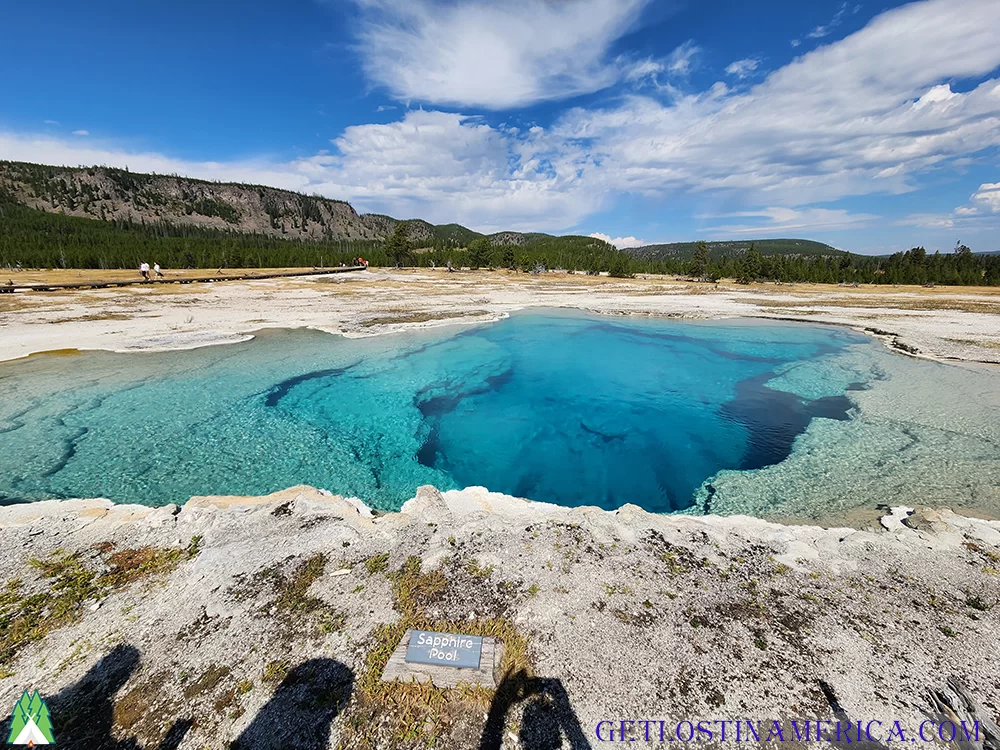
Biscuit Basin, Sapphire Pool Yellowstone National Park Changed for ever by the Hebgen Lake Earthquake. Sapphire Pool is along the Continental Divide Trail, in the section between Old Faithful and Summit Lake.
Eruptions observed in numerous springs were just one part of this natural upheaval. Old Faithful’s intervals increased significantly as well; what was once predictable became less so, challenging previous records of regularity and prompting a reevaluation of how we understand these geological phenomena. This shows us that patterns we once thought were unchangeable in the natural world can unexpectedly be thrown off course.
If you’re intrigued by the aftermath of Montana’s most powerful quake, the 7.3 Hebgen Lake shake-up, detailed explorations await your curiosity here. The information sheds light on how seismic activity influences geyser basins not only immediately post-event but also over extended periods as landscapes gradually stabilize from such profound disturbances.
In essence, while Yellowstone continues to awe with its geothermal wonders like Sapphire Pool and Seismic Geyser under skies streaked by eruptions against an ever-changing backdrop shaped by both time and tumultuous events beneath Earth’s crust—it serves as a stark reminder: Nature holds dominion here; we’re merely spectators granted passage through her domain.
This dance between creation and destruction woven throughout Yellowstone’s history tells us stories far beyond mere human comprehension—each steam vent or bubbling pool whispers secrets stretching back millennia before our arrival.
To explore further about how earthquakes influence other aspects such as wildlife behavior or cultural reflections stemming from natural disasters within this unique ecosystem provides endless opportunities for discovery amidst America’s first national park’s enduring legacy forged from fire ice…and quakes.
The 1959 Hebgen Lake earthquake transformed Yellowstone’s hydrothermal features, showing nature’s power to reshape landscapes and challenge our understanding of geological patterns. This event highlights the park’s ever-changing beauty and the dynamic relationship between Earth’s forces and its surface wonders.
Ripple Effect on Wildlife and Environment
When the 1959 Hebgen Lake earthquake struck, it didn’t just shake the ground; it stirred a transformation across Yellowstone’s ecosystem. The earthquake triggered a profound metamorphosis in the park’s wildlife and vegetation, illustrating nature’s resilience.
Cubic Yards of Change: How Flora Adapted
The aftermath of the quake was marked by approximately 50 million cubic yards of debris altering the landscape. The abrupt transformation not only rerouted waterways but also birthed novel ecosystems for flora to thrive in. Some areas previously dense with vegetation became barren landscapes, while others transformed into lush environments due to increased moisture from redirected water sources.
In these newly formed terrains, pioneer species quickly took root. These hardy plants are known for their ability to colonize disturbed soil, essentially setting the stage for more complex ecosystems to develop over time. Over time, these areas blossomed into vibrant ecosystems, displaying the enduring power of nature’s recovery.
Wildlife Wonders: Animal Kingdom’s Response
In Yellowstone National Park, the tremor served as a double-edged sword for its inhabitants, unveiling hurdles and prospects alike. Habitat alterations forced some species to migrate in search of food and shelter while enabling others to thrive in new niches that emerged post-disaster.
Predators such as wolves found hunting grounds expanded as prey animals like elk moved into open spaces created by landslides and rock slides blocked traditional routes through forests or valleys floor damaged highways trapped them inside newfound territories leading panicked tourists. The reshaping of ecosystems highlighted the intricate web linking habitat frameworks and the survival tactics animals adopt, adapting to evolving climates.
Pondering the aftermath of a single night’s quakes, we’re drawn to marvel at Yellowstone’s ever-changing landscape—a narrative not solely about the geological shifts but also a profound tale of resilience and coexistence woven by all creatures that inhabit this land.
The 1959 Hebgen Lake earthquake didn’t just shake Yellowstone; it sparked a transformation, reshaping habitats and challenging wildlife. This event highlights nature’s power to adapt and thrive amidst change, showcasing the resilience of both flora and fauna in face of environmental shift
Cultural Reflections on Natural Disasters
Accounts from those who’ve weathered nature’s fury are far more than mere survival logs; they’re intricate chronicles showcasing the unyielding fortitude of our spirit. The 1959 Hebgen Lake earthquake, with its magnitude of 7.3 and tragic toll of 28 lives lost, left behind more than just geological changes; it imprinted lasting memories on those who lived through it.
In the wake of this catastrophe, miles WNW from Yellowstone National Park’s western boundary, landscapes transformed overnight. But perhaps more impactful were the shifts in community dynamics and cultural reflections these events spurred. Amidst the chaos of shifting stones and transformed geysers, folks found solace in sharing tales that spun a fabric showcasing both singular courage and united resilience.
The Echoes Through Generations
Survivor accounts have been meticulously passed down over time, painting vivid pictures of panic as panicked tourists scrambled for safety while highways trapped them within nature’s fury. These narratives often highlight moments where humanity shone brightly against a backdrop filled with chaos—tales where fear was met with courage as families clung together under starless skies shaken by seismic forces.
The transformation wasn’t limited to physical alterations like fault scarps or the creation of Earthquake Lake due to massive landslides carrying debris across Madison River Valley floor. It also sparked an evolution in how communities understand and prepare for such unpredictable events—a shift underscored by discussions at places like Forest Service Museum exhibits, which detail rescue operations following one of Montana’s largest earthquakes.
A Legacy Carved By Nature’s Force
Beyond immediate recovery efforts lies an enduring legacy shaped by this event—one marked not only by changed landscapes but also enriched communal bonds forged through shared experiences during times when Old Faithful Inn seemed less safe than ever before under Yellowstone volcano’s shadow. The tremor served as a catalyst, enhancing our understanding of seismic waves and Earth’s cryptic signals—showcasing the brilliance of human creativity in overcoming obstacles. For instance, lectures hosted by Montana State Historical Society delve into insights gained post-disaster about our planet’s intricate geological processes. Our story highlights the profound bond we share with the natural world, emphasizing the importance of grasping this connection to equip upcoming generations for facing akin obstacles.
Hebgen Lake Earthquake Note:
Survivor stories from the 1959 Hebgen Lake earthquake highlight resilience and community strength in the face of disaster, sparking shifts in how we prepare for and understand natural events. This event’s legacy lives on through improved seismology and stronger communal bonds.
The Role Of Technology In Understanding Seismic Events
When the earth decides to shake things up, technology steps in as our crucial ally. The Hebgen Lake quake vividly illustrates the evolution in seismology, reshaping our strategies for grasping and gearing up against tremors.
Leveraging Data for Future Safety
Following catastrophes akin to the Hebgen Lake quake, our reliance on geological surveys escalates as they morph into crucial instruments for deciphering Earth’s subterranean secrets. Acting as our subterranean vision, they unveil mysteries that previously eluded us, making the invisible visible. For instance, by studying fault scarps and rock slides at Creek Campground, scientists can unravel the dynamics of such catastrophic events.
The information we gather isn’t merely for scholarly pursuits; it plays a crucial role in saving lives. By honing in on construction norms and shaping crisis management tactics, this knowledge arms neighborhoods adjacent to fault zones with the tools they need to stand firm against forthcoming tremors. Additionally, this data acts as a beacon in crafting sturdy structures that can endure the might of earthquakes.
Consider how detailed mapping of areas around Hebgen Dam or Rock Creek Campground has led to improved safety measures against potential dam failures or landslides—critical concerns that emerged post-quake. With tireless dedication, utilizing cutting-edge tools such as subsurface imaging tech and precise location tracking devices, researchers tirelessly refine our preparedness strategies.
Tech doesn’t stop there though—it also transforms tragedy into teaching moments through virtual simulations based on real-life disaster scenarios allowing both experts and laypeople alike an immersive learning experience about earthquakes’ might without facing their wrath firsthand. Merging knowledge, vigilance, and hands-on use showcases the pivotal role of tech progress in not just interpreting the whispers of our planet but also preparing us for its unpredictable moods.
As we look back at Yellowstone’s altered landscape—from new lakes formed overnight to shifted geyser basins—the role technology plays becomes clear: it gives us hope. By harnessing data from past quakes, we’re writing humanity’s playbook on resilience; turning lessons learned into actionable knowledge designed not just survive but thrive amidst Earth’s unpredictable shifts.
Technology is our key ally against earthquakes, turning tragic events like the Hebgen Lake quake into lessons for future safety. By using advanced tools and data analysis, we’re not just understanding Earth’s shakes better but also building stronger communities ready to face them.
Navigating Recovery And Resilience In Yellowstone
Bridging Back To Normalcy
After the 1959 Hebgen Lake earthquake shook the foundations of Yellowstone, a mammoth task lay ahead: rebuilding lives and infrastructure. The quake went beyond mere geological upheaval, deeply affecting the everyday existence of countless individuals. Reconstructing the damaged highways that trapped tourists became an urgent priority.
In the midst of turmoil, the collective heart of our community glimmered with unwavering resolve. From Rock Creek Campground to West Yellowstone, locals and authorities banded together in a monumental effort to restore normalcy. Today, their steadfastness is evident in the way paths were unblocked, functions reinitiated, and safeguards established to avert forthcoming calamities.
A key part of this journey back was understanding what happened at places like Earthquake Lake—formed overnight by landslides carrying debris into Madison River—and ensuring such phenomena could be better managed or mitigated going forward.
Fostering Community Strength
In facing nature’s fury head-on, the people affected by Montana’s largest recorded earthquake showcased an incredible strength of character. Stories emerged from survivors who watched large rock chimneys collapse yet remained steadfast in their resolve to rebuild their communities from scratch if needed.
This ordeal also highlighted how important preparedness is when living on top of one of the world’s most significant volcanic hotspots—the nearby Yellowstone National Park with its geyser basins and hydrothermal features underwent sudden changes too after all.
To bolster this newfound unity and ensure long-term resilience against similar threats, initiatives sprang up focusing on seismic education—a crucial step towards preventing panic during such disasters in the future. Lessons learned here would help guide recovery efforts elsewhere too; demonstrating once more that through adversity comes wisdom for tomorrow’s challenges.
For those looking deeper into how exactly these recovery operations unfolded post-disaster, the Montana State Historical Society offers detailed lectures that provide insights into both immediate responses and long-term strategies following events like these.
The 1959 Hebgen Lake earthquake taught us the power of community and preparedness in facing disasters. Rebuilding efforts highlighted the importance of unity, resilience, and education to overcome adversity and safeguard for future challenges.
A Legacy Carved By Nature’s Force
In 1959, the Hebgen Lake quake not only wrought havoc as a formidable natural calamity but also redefined Yellowstone’s terrain and existence with its legacy etched through landslides. On that fateful night, nature’s force unleashed itself through fault scarps and seismic waves, altering the valley floor of this iconic region.
In the aftermath, the creation of Earthquake Lake stood as a stark testament to the quake’s formidable might. Born from a massive landslide carrying approximately 50 million cubic yards of debris damming Madison River, this new water body became both a testament to devastation and resilience. Nearby campsites like Rock Creek Campground bore witness to these dramatic changes firsthand.
Yet amid destruction lay opportunities for learning and growth. Following the earthquake, the ramped-up geological studies have yielded rich knowledge about the transformation of terrains in its aftermath. This has allowed scientists to better understand other phenomena within the area too – including those involving Yellowstone volcano on its western boundary or hydrothermal features across geyser basins altered by sudden northward tilting during the quake.
Tales From Survivors: Bridging Past And Future
Narratives shared by distraught travelers, ensnared amidst wrecked roads, underscore our fragility against the formidable forces of nature while simultaneously shining a spotlight on astounding sagas of endurance – steering us to cultivate communal resilience in the face of hardship.
This event not only changed physical geography but also etched deep emotional scars on those who lived through it—leading survivors to reflect upon their experiences in ways that bridge generations together over shared stories about surviving natural disasters with courage and hope for recovery despite overwhelming challenges faced during rescue operations.
Technological Advancements Post-Quake: A New Dawn In Seismology
The aftermath saw leaps in technology used for understanding seismic events more clearly than ever before thanks largely due advancements made possible by lessons learned from analyzing data collected after Montana earthquake shook ground beneath our feet so violently decades ago now paving way safer future where we may one day predict such calamities before they strike giving us chance save lives process rather than merely responding aftermath already occurred scenario many wish could avoid altogether if given choice do so today versus yesterday thinking back then what know now makes all difference world when comes preparedness facing mother earth her most unpredictable moments rage fury alike still there hope horizon always will be long continue learn adapt grow together society whole moving forward never forgetting past yet embracing tomorrow come what may side caution optimism combined healthy respect forces beyond control remind why important stay vigilant watchful skies above below wherever find ourselves standing moment notice ready act accordingly should need arise again someday soon hopefully later rather sooner knowing full well equipped knowledge gained hard way unfortunately sometimes only teach best lessons ones never forget once learned first. Embarking on this path, driven by determination and an unwavering quest for advancement, illuminates the strides we’ve made as well as the ongoing journey of discovery that lies before us. It underscores a collective commitment to enhancing our preparedness against nature’s might, armed with better tools and deeper insights—because being forewarned is being forearmed.
The 1959 Hebgen Lake earthquake transformed Yellowstone, creating Earthquake Lake and altering landscapes. It spurred scientific advancements in seismology and taught us the power of community strength in adversity. This event underlines the importance of learning from nature’s fury to better prepare for future disasters.
FAQs in Relation to Before and After 1959 Hebgen Lake Earthquake
What happened at Hebgen Lake in 1959?
In 1959, a massive earthquake hit near Hebgen Lake, creating Earthquake Lake and altering the landscape dramatically.
How many people died in the hebgen lake earthquake?
The quake claimed 28 lives, making it one of Montana’s deadliest natural disasters.
What National Park did the 1959 Hebgen Lake earthquake occur just west of?
This seismic event shook ground just west of Yellowstone National Park.
What happened to the north shore of Hebgen Lake?
The north shore was heavily damaged, with landslides and flooding reshaping its geography significantly.
Conclusion of Before and After 1959 Hebgen Lake Earthquake
The night of August 17, 1959, forever altered the course of Yellowstone. The before and after 1959 Hebgen Lake earthquake narrative teaches us about nature’s unpredictable power and how it shapes our world.
Reflect on the unwavering spirit displayed during the salvage endeavors. Recall the birth of Earthquake Lake as a testament to natural forces at work. Reflect on how even Yellowstone’s geysers didn’t escape unscathed.
Remember, calamities have a unique way of uniting neighborhoods and forging bonds. Realizing the significance of comprehending earthquakes now can pave the way for enhanced protection down the line.
This story isn’t just history; it’s a guide on navigating recovery and fostering strength amidst chaos.
Camp on Hebgen Lake Near Quake Lake Explore History
Fly fish the Madison River, while camping on the banks of Hebgen Lake. Journey to Livingston, Montana to fly fish Spring Creeks. Or how about a Canadian Brook Trout Adventure?

